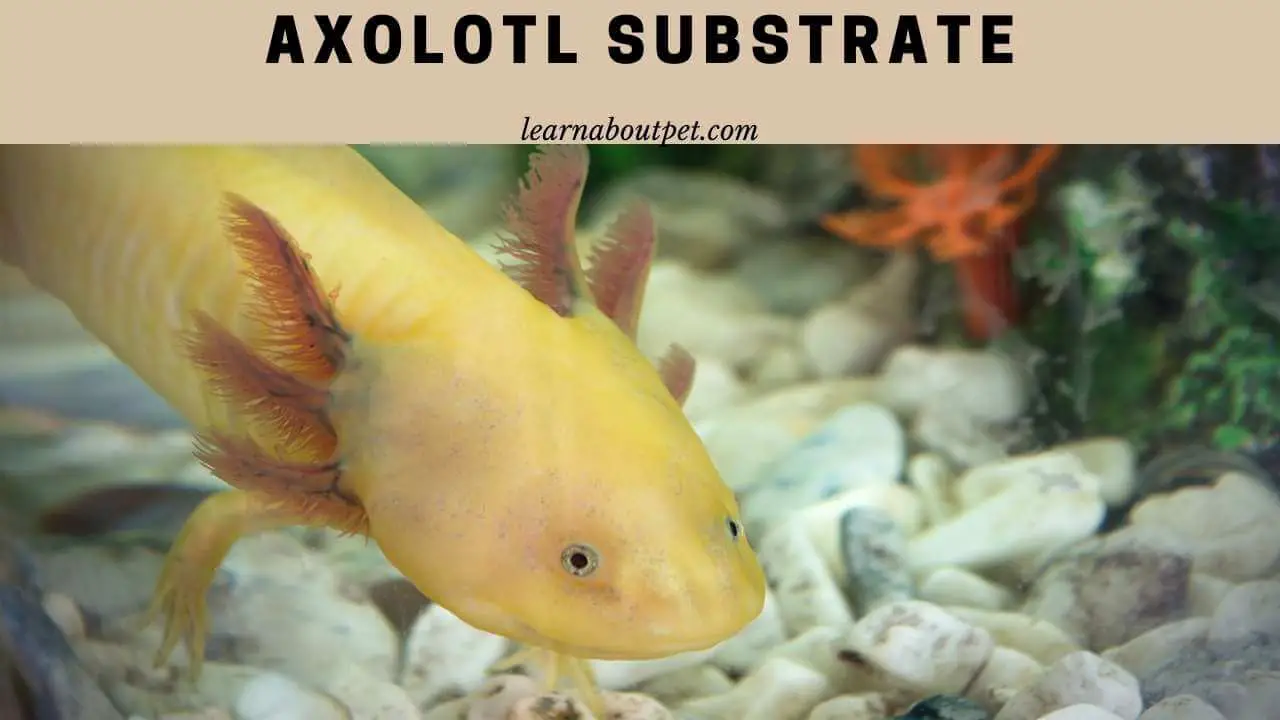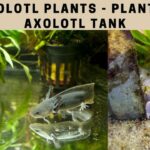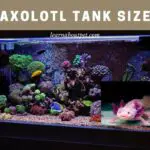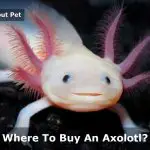Providing a suitable habitat for the axolotl is the owner’s duty to provide a healthy life and achieve the axolotl’s life expectancy. Axolotl tanks can have a design that is close to their natural habitats. Give it to caves, live plants, and substrates. Since axolotls are silly creatures that can eat anything they see, you should place a lot of importance on the axolotl tank substrate you will use.
Is your Axolotl Substrate safe? Terrarium Sand & Aqua Terra’s Aquarium is an ideal substrate for axolotls. These aquarium-safe sand will deal with the axolotl’s infesting gravel habit. If you use gravel, the axolotl can swallow it, and the axolotl can experience gut impactions that can lead to death.

Learning about the substrate for axolotls can be your reference for treating axolotls as much as possible. Let’s read this article to the end to know more about axolotl substrate.
What Is The Best Substrate For Axolotls?
Substrate for axolotl has a huge role to keep the axolotl safe while in the tank because adult axolotls spend more of their time at the bottom of the tank. If you put in a hard substrate that they can swallow, the effect will reduce their life expectancy and lead to death.
Sand substrate is the best choice because its soft form will not be a problem even if the axolotl eats sand accidentally. Please note that the sand axolotl substrate will only be safe for adult axolotl but can still be dangerous for young axolotls.
Many axolotl owners choose not to provide substrate in the axolotl tank because they think that if there is no substrate, there is also no risk that the axolotl will be exposed to a choking hazard or ingesting substrate.
The cons are that the bottom tank becomes slippery, and the axolotl is difficult to walk. You also can’t put live plants in the bottom of the tank. It becomes easier when you want to clean the tank from axolotl’s waste.
What Should I Put On The Bottom Of My Axolotl Tank?
Choose fine sand for the axolotl substrate and place it all over the bottom of the tank. If you want to put rocks, put rocks that are much bigger than the axolotl’s head so they can’t swallow them. Give a special design for axolotls to rest or hide, such as piles of rocks or caves.
You can put live plants that can grow after you put the sand. Since the axolotl needs space without too much light, ensure the plant can live even if it is not exposed to much sunlight.
You will be safe when placing sand as a substrate after your axolotl reaches adulthood because axolotl will be safe even if a lot of sand enters their body. After all, the sand will not stay in their body for a long time.
Do Axolotls Prefer Sand Or Gravel?
As an axolotl, any substrate will be appreciated. But as axolotl owners, you have to think about some of the risks that can occur if you put the wrong substrate for your axolotl.
For example, when you have a juvenile axolotl and accidentally swallow gravel and become stomach blockage, that can lead to death. Your axolotl will not be able to reach adulthood.
As owners, understanding the axolotl substrate type will make it easier for you to decide which substrate is safe according to the age of the axolotl.
Axolotl will not tell you directly which substrate is more suitable for their tank because you are in control of whatever is in the axolotl tank.
Can I Use Reptile Sand For Axolotl?
Avoid using sand reptile tanks if there is calcium carbonate because it can quickly disrupt the pH level in the tank. Axolotls are animals that are sensitive to water conditions. They can change their behavior and endanger their health if left to live at an inappropriate pH level.
Axolotl substrate in aquarium cannot be compared to reptiles on land because special fine sand for tanks is also made to suit the needs of aquatic pets. Pure aquarium sand is the best axolotl substrate because it is much safer than using gravel.
Please do not use reptile sand because it is not suitable for axolotls even though they are salamanders. If you keep it, the axolotl will not be comfortable in your tank and may not last more than a month or two.
Should I Put Sand At The Bottom Of My Axolotl Tank?
Sand is finely placed on the axolotl tank up to 3 inches to make it easier for them to walk on the bottom of the tank. Although the axolotl can inhale the sands, it will pass without hassle.
You still have to choose the suitable axolotl sand because not all sand can be used for axolotl tanks. Avoid using sand that has calcium carbonate. Use pure aquarium sand before you find other aquatic sand suitable for axolotl tanks.
Put the best axolotl substrate will prevent the axolotl from being swallowed by the big substrate which can become an intestinal blockage.
What Kind Of Sand For Axolotl Is Good?
Choosing the suitable sand will also help you in ensuring the axolotl’s health while in captivity. The table below shows some of the things that an axolotl tank substrate needs to have.
| Sand requirements | Details |
| pH neutral | Good sand will not affect the pH level in the tank. |
| No dyes or paints | Dyes or paints on the sand will easily contaminate the tank, and your axolotl can be poisoned at some level. |
| Non-toxic | Although the sand has a soft shape, do not use sand that has toxic materials for axolotls. |
| Good for plants | Choose sand that can be used to place live plants and make plants continue to grow. |
Sand is an axolotl substrate that has almost no bad risk for your axolotl. Immediately choose the right aquarium sand for your axolotl, and they can be happy in their new habitat.

Is Aragonite Sand Safe For Axolotl?
If you use salt water for your axolotl tank, you can use aragonite to raise the pH level. Axolotl should be fine with tanks that use aragonite as a substrate. If the axolotl tank has a sufficient pH level, you can use normal aquarium sand instead of aragonite.
Choosing a suitable substrate for axolotl is one of axolotl care because keeping the axolotl healthy and fulfilling several tank requirements is the responsibility of every owner.
Check the pH level when you use aragonite. If you notice that the pH level is too high from 7.4-7.6, it can be stressful for the axolotl.
Is Sand Okay For Baby Axolotls?
You can leave the axolotl tank without sand while you still have young axolotls because sand is still dangerous for them. The small bodies of baby axolotls are dangerous if they inhale too much of the sands because axolotl substrate can become a blockage in their breathing if too much.
If you want to have a baby axolotl substrate, use gravel with a size that is much larger than its mouth. It is still safe for them as long as they are not eaten. If the axolotl size has started to grow you need to replace the gravel with a larger substrate.
Use sand as a substrate when the axolotl is more than 6 months old. When axolotls are starting to grow larger, it won’t be a big problem if they have eating sands or inhaling sands.
Will Axolotls Eat Sand?
Axolotls are silly creatures that can eat their poop. Although they don’t eat sand right away, there are many chances that axolotls will accidentally eat sand when they want to reach for food that has fallen to the bottom of the tank.
This will not be a problem for adult axolotls as the sand will pass through without causing any problems. Sand is an axolotl substrate that will not create any blockage.
Placing sand in the axolotl habitat is safe if the axolotl is an adult. Don’t take the risk of putting sand in the tank when the axolotl is young, so it doesn’t become a big problem whether the axolotl eats it intentionally or not.
Is Gravel Bad For Axolotl?
Say no to gravel if you want to see axolotls growing healthy in a tank. Gravels will only add to the problem for the axolotl because it can become a stomach blockage and choking hazard at any age. Putting gravel in the axolotl is like putting a time bomb which can cause an accident at any time.
Gravels can be a safe substrate only if the size of your axolotl is still small and the axolotl gravel cannot be eaten by them. If the size of the axolotl is getting large, don’t hesitate to change the substrate to a safer one.
Do not use gravel as an axolotl substrate because it can create an impaction that can lead to death.
Axolotl Substrate Ideas
To avoid any injuries, you can put a safe axolotl substrate with several designs to make the tank environment beautiful at the same time. Look up the axolotl substrate Reddit ideas reference to see how axolotl owners put aquarium sand and other materials like rocks, caves, or plants.
Look for natural sand, and stir it up before putting it in the tank. Processing the sand first is needed to prevent air pockets that can expose the axolotl to gas or bacteria. Smooth sand will not irritate the axolotl’s skin and will not cause impaction if the axolotl is an adult.
You can put rocks in various parts of the tank and make sure the rocks are 2-3 times larger than the axolotl’s head. Good rocks do not have sharp edges so as not to cause injury to the axolotl.
Choose special gravel for the aquarium, do not choose gravel from a building shop because it will have a bad effect on the water parameters.
Put live plants that can live when you put sand or large rocks with a minimum need for sunlight and withstand cool temperatures. Live plants are acceptable to be a filter even though it is not as strong as a water filter.
Make a place for the axolotl to hide because axolotl can use it when he wants to sleep. If you put an axolotl tank that can still be exposed to sunlight, the axolotl will use the caves to avoid direct sunlight because they are sensitive to sunlight.
What Do Axolotls Need In Their Tank?
Axolotls need at least 10-gallon of water because they produce a lot of waste. The most important axolotl tank setup is related to water parameters. Water filters cycled tanks, substrates, live plants, and caves will complete the axolotl’s needs.
What do axolotls need in their tank? Axolotl tanks must have a pH level of 7.4-7.6 and ammonia and nitrites level at 0 ppm. Since the axolotl is sensitive to water conditions, you need to change 20-30% of the water every week.
Final Verdict On Axolotl Substrate
The substrate is important in the axolotl tank because it can give the axolotl a sense of security for a long time. Pay attention to the age of your axolotl. If it is still young, you can provide substrates such as large rocks or not use substrates even though there are some disadvantages.

If the axolotl is an adult, the safest substrate is smooth sand which is specially used in the aquarium because it is free from the possibility of impaction, choking hazard, or infection. Although axolotl inhales the sands, it will not cause long-lasting ill effects.
The problem that occurs is the owner’s mistake in choosing the axolotl substrate because the axolotl can eat whatever is in the tank. If the owner uses gravel and the axolotl accidentally swallows it, the axolotl can die from intestinal blockage or choke to death.

Welcome to Learn About Pet. My name is Rajkumar Ravichandran and I love all pets, travel, and amazing food. I write about my passion and personal experience caring for multiple pets in this blog! ❤️
Post Disclaimer
DISCLAIMER: THIS BLOG OR WEBSITE, "Learn About Pet", DOES NOT PROVIDE YOU WITH MEDICAL ADVICE AND IS NOT A SUBSTITUTE FOR MEDICAL ADVICE. ALWAYS GET IN TOUCH WITH YOUR PERSONAL VETERINARIAN AND USE INFORMATION HERE AS GENERAL ADVICE.
The information, including but not limited to, text, graphics, images and other material contained on this website are for informational purposes only. No material on this site is intended to be a substitute for professional veterinary advice, food recommendation, diagnosis, or treatment. Always seek the advice of your veterinarian or other qualified health care provider with any questions you may have regarding a medical condition or for pet food related questions.







